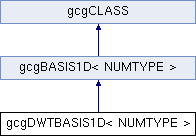|
| bool | setWavelets (gcgDISCRETE1D< NUMTYPE > *H, gcgDISCRETE1D< NUMTYPE > *G, gcgDISCRETE1D< NUMTYPE > *rH, gcgDISCRETE1D< NUMTYPE > *rG) |
| | Sets the filters for decomposition and reconstruction. The filters information is copied to the internal filters. The internal border extension attribute is set to GCG_BORDER_EXTENSION_ZERO since wavelet basis are assumed to be compact and finite. Call it BEFORE projectSignal(), reconstructSignal() or basisInformation(). More...
|
| |
| bool | setNumberOfSamples (unsigned int nsamples) |
| | Sets the number of samples to be used in the projection/reconstruction processes. Call it BEFORE projectSignal(), reconstructSignal() or basisInformation(). More...
|
| |
| unsigned int | getNumberOfCoefficients () |
| | Returns the number of elements needed to store the coefficients of the projection of nsamples (see setNumberOfSamples()) onto the wavelet basis. If nsamples is even, there will be nsamples coefficients. If nsamples is odd, there will be (nsamples + 1) / 2 coefficients. The first half of the coefficients vector are scale coefficients given by low pass filtering (approximation). The second half of the coefficients vector are detail coefficients given by high pass filtering. More...
|
| |
| bool | projectSignal (int atX, gcgDISCRETE1D< float > *vector, gcgDISCRETE1D< NUMTYPE > *outputcoef) |
| | Computes the coefficients of the projection of the vector (as 1D signal) onto the wavelet basis. Only nsamples elements starting at position atX are used. This subregion is projected using the original signal vector extension mode. User must be carefull because most wavelets only works with periodic and/or symmetric extension of the signal. Call setNumberOfSamples() to set the number of samples to be used. More...
|
| |
| bool | reconstructSignal (int atX, gcgDISCRETE1D< NUMTYPE > *inputcoef, gcgDISCRETE1D< float > *outputvector) |
| | Computes up to nsamples components of a vector (as 1D signal), using the scale and detail coefficients given in array inputcoef (as 1D signal). The components are stored in the array outputvector (as 1D signal) starting at position atX. Call setNumberOfSamples() to set the number of samples to be used. More...
|
| |
| bool | basisInformation (const char *filename) |
| | Output information using current wavelet basis for numerical analysis. Saves information of reconstructions using the basis with nsamples elements. Call setNumberOfSamples() to set the number of samples to be used. More...
|
| |
| void * | operator new (size_t size) |
| | Defines a new operator to be used by instatiations of GCGlib classes instead the global one. More...
|
| |
| void * | operator new (size_t size, const std::nothrow_t &) throw () |
| | Defines a new operator to be used by instantiations of GCGlib classes instead the global one. Returns a NULL pointer instead of throwing an exception if an error occurs. More...
|
| |
| void * | operator new[] (size_t size) |
| | Defines a new operator to be used by GCGlib array allocations instead the global one. More...
|
| |
| void * | operator new[] (size_t size, const std::nothrow_t &) throw () |
| | Defines a new operator to be used by vector allocations instead the global one. More...
|
| |
| void | operator delete (void *p) |
| | Defines a delete operator to free instances of GCGlib classes instead the global one. It is designed to match the new operator. More...
|
| |
| void | operator delete (void *p, const std::nothrow_t &) throw () |
| | Defines a delete operator to free instances of GCGlib classes instead the global one. It is designed to match the new operator. More...
|
| |
| void | operator delete[] (void *p) |
| | Defines a delete operator to free instances of arrays for GCGlib classes instead the global one. It is designed to match the new[] operator. More...
|
| |
| void | operator delete[] (void *p, const std::nothrow_t &) throw () |
| | Defines a delete operator to free instances of arrays for GCGlib classes instead the global one. It is designed to match the new[] operator. More...
|
| |
template<>
class gcgDWTBASIS1D< NUMTYPE >
Class for real, discrete, wavelets decomposition and recomposition.
- Template Parameters
-
| NUMTYPE | Type of the samples representing the signal. Supported types: float or double. |
Use gcgDWTBASIS1D<float> for single precision and gcgDWTBASIS1D<double> for double precision. Methods for projection and reconstruction are avalaible.
- Since
- 0.01.6



 Public Member Functions inherited from gcgCLASS
Public Member Functions inherited from gcgCLASS